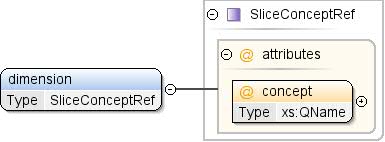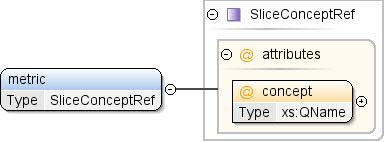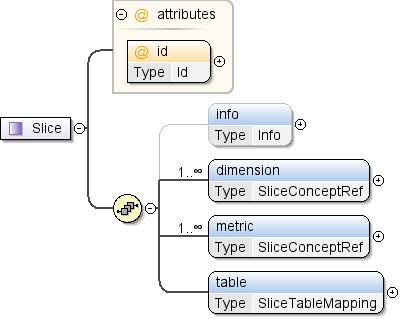Komponente: Slice
Mit Sammlungen den Überblick behalten
Sie können Inhalte basierend auf Ihren Einstellungen speichern und kategorisieren.
Element: Segment / Informationen
| Namespace |
http://schemas.google.com/dspl/2010 |
| Annotationen |
Textinformationen zum Segment. |
| Diagramm |
 |
| Typ |
Info |
| Attribute |
| content: |
komplex |
| minOccurs (Mindestanzahl): |
0 |
|
| Modell |
name , description{0,1} , url{0,1} |
| Children |
Beschreibung, Name, url |
| Instanz |
<info>
<name>{1,1}</name>
<description>{0,1}</description>
<url>{0,1}</url>
</info>
|
| Quelle |
<xs:element name="info" type="Info" minOccurs="0">
<xs:annotation>
<xs:documentation>Textual information about the slice.</xs:documentation>
</xs:annotation>
</xs:element>
|
Element: Segment / Dimension
| Namespace |
http://schemas.google.com/dspl/2010 |
| Diagramm |
 |
| Typ |
SliceConceptRef |
| Attribute |
| content: |
komplex |
| maxOccurs: |
unbegrenzt |
|
| Attribute |
| QName |
Typ |
Behoben |
Standard |
Verwenden |
Annotation |
| Konzept |
xs:QName |
|
|
erforderlich |
Konzept, dem die Dimension oder der Messwert entspricht
|
|
| Quelle |
<xs:element name="dimension" type="SliceConceptRef" maxOccurs="unbounded"/>
|
Element: Segment / Messwert
| Namespace |
http://schemas.google.com/dspl/2010 |
| Diagramm |
 |
| Typ |
SliceConceptRef |
| Attribute |
| content: |
komplex |
| maxOccurs: |
unbegrenzt |
|
| Attribute |
| QName |
Typ |
Behoben |
Standard |
Verwenden |
Annotation |
| Konzept |
xs:QName |
|
|
erforderlich |
Konzept, dem die Dimension oder der Messwert entspricht
|
|
| Quelle |
<xs:element name="metric" type="SliceConceptRef" maxOccurs="unbounded"/>
|
Element: Segment / Tabelle
| Namespace |
http://schemas.google.com/dspl/2010 |
| Annotationen |
Eine Zuordnung zu einer Tabelle, in der die Segmentdaten
darauf zugegriffen wurde. |
| Diagramm |
 |
| Typ |
SliceTableMapping |
| Attribute |
|
| Modell |
mapDimension* , mapMetric* |
| Children |
mapDimension, mapMetric |
| Instanz |
<table ref="">
<mapDimension concept="" toColumn="">{0,unbounded}</mapDimension>
<mapMetric concept="" toColumn="">{0,unbounded}</mapMetric>
</table>
|
| Attribute |
| QName |
Typ |
Behoben |
Standard |
Verwenden |
Annotation |
| Ref. |
xs:QName |
|
|
erforderlich |
Die Kennzeichnung der Tabelle, die Daten für die
Slice. |
|
| Quelle |
<xs:element name="table" type="SliceTableMapping">
<xs:annotation>
<xs:documentation>A mapping to a table where the slice data can be
accessed.</xs:documentation>
</xs:annotation>
</xs:element>
|
Komplexer Typ: Slice
| Namespace |
http://schemas.google.com/dspl/2010 |
| Annotationen |
Ein Slice beschreibt eine Kombination von Konzepten, für welche Daten
existiert. Metriken sind die Konzepte,
die Werte liefern, während Dimensionen
sind die Konzepte, mit denen
auf diese Werte zugegriffen wird. Genauer gesagt,
Dimensionen sind ein Primärschlüssel für die Daten des Slice. Das heißt, für alle
Kombination von Werten der Dimensionen. Es ist höchstens eine Datenzeile in
das Slice. Segmente in einem Dataset müssen die folgenden Anforderungen erfüllen:
Zwei Dimensionen oder Messwerte in einem Segment dürfen sich nicht auf dasselbe Konzept beziehen. –
Es dürfen keine zwei Segmente im Dataset
die gleichen Dimensionen und
Messwerte. |
| Diagramm |
 |
| Verwendet von |
|
| Modell |
info{0,1} , Dimension+ , Messwert+
, Tabelle |
| Children |
Dimension, Informationen, Messwert
Tabelle |
| Attribute |
| QName |
Typ |
Behoben |
Standard |
Verwenden |
Annotation |
| id |
ID |
|
|
erforderlich |
Die eindeutige Kennung des Slice. |
|
| Quelle |
<xs:complexType name="Slice">
<xs:annotation>
<xs:documentation>A slice describes a combination of concepts for which data
exists. Metrics are the concepts that provide values, while
dimensions are the concepts used to access these values. More
precisely, the dimensions are a primary key for the data of
the slice. That is, for any combination of values of the
dimensions, there is at most one data row in the slice.
Slices in a dataset must follow the following requirements:
- No two dimensions or metrics in a slice may refer to the
same concept.
- No two slices in the dataset may have the same dimensions
and metrics.</xs:documentation>
</xs:annotation>
<xs:sequence>
<xs:element name="info" type="Info" minOccurs="0">
<xs:annotation>
<xs:documentation>Textual information about the slice.</xs:documentation>
</xs:annotation>
</xs:element>
<xs:element name="dimension" type="SliceConceptRef" maxOccurs="unbounded"/>
<xs:element name="metric" type="SliceConceptRef" maxOccurs="unbounded"/>
<xs:element name="table" type="SliceTableMapping">
<xs:annotation>
<xs:documentation>A mapping to a table where the slice data can be
accessed.</xs:documentation>
</xs:annotation>
</xs:element>
</xs:sequence>
<xs:attribute name="id" type="Id" use="required">
<xs:annotation>
<xs:documentation>The unique identifier of the slice.</xs:documentation>
</xs:annotation>
</xs:attribute>
</xs:complexType>
|
Attribut: Segment / @id
| Namespace |
Kein Namespace |
| Annotationen |
Die eindeutige Kennung des Slice. |
| Typ |
ID |
| Attribute |
| verwenden Sie zum Beispiel: |
erforderlich |
|
| Attribute |
|
| Verwendet von |
|
| Quelle |
<xs:attribute name="id" type="Id" use="required">
<xs:annotation>
<xs:documentation>The unique identifier of the slice.</xs:documentation>
</xs:annotation>
</xs:attribute>
|
Erstellt mit dem
oXygen XML Editor
Sofern nicht anders angegeben, sind die Inhalte dieser Seite unter der Creative Commons Attribution 4.0 License und Codebeispiele unter der Apache 2.0 License lizenziert. Weitere Informationen finden Sie in den Websiterichtlinien von Google Developers. Java ist eine eingetragene Marke von Oracle und/oder seinen Partnern.
Zuletzt aktualisiert: 2025-07-25 (UTC).
[null,null,["Zuletzt aktualisiert: 2025-07-25 (UTC)."],[],["The core content defines the structure of a \"Slice,\" a combination of concepts with data. Each slice has a unique identifier and includes textual information, dimensions, metrics, and a table mapping. Dimensions and metrics refer to concepts, and their values are used to access data. The table mapping connects the slice to a specific data table. Slices cannot share dimensions or metrics and must have a unique ID. Dimensions and Metrics are defined with a concept.\n"]]




